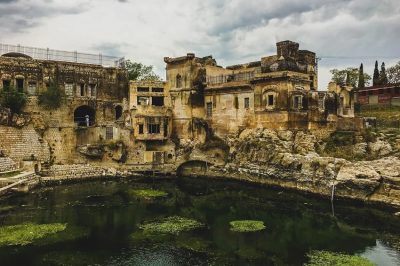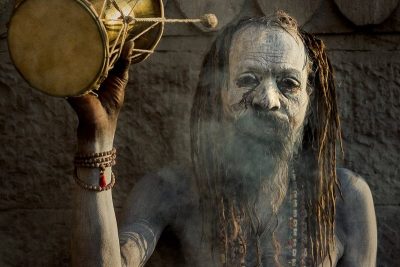Whale Temple: Where Vietnamese Worship Whales and Revere their Carcasses
Share

Whale skeletons at the Van Thui Temple, Vietnam. (Bùi Thụy Đào Nguyên/Wikimedia Commons)
Worshipping of idols and building temples for deities with manmade figures of gods and goddesses, is an important part of some major religions of the world. And there are some temples in the world where the object of worship is real, once part of the living world. In the Southeast Asian country of Vietnam, there are dozens of unusual temples dotting the coastline where beached whales are worshipped and the carcasses of cetaceans that wash up dead on the shores are given a proper burial.
How whale worship came to be in Vietnam
The Socialist Republic of Vietnam has had a long history of land and sea migration, with people mostly coming in from neighbouring China. When China ruled over the country, cultural influences of Cantonese origin rubbed off on the Vietnamese. The Chinese were seafaring people, who mostly undertook voyages for trade, travel and leisure; but the journeys were not as easy and effortless as they are in today’s world. This led to many sailors either getting lost at sea in rough weathers or drowning in the choppy tides. The Chinese believed it was the Goddess of Sea – Mazu, who punished them for their sins. And to avoid facing her wrath, people built temples for Mazu, who sailors would thank upon their safe return to land.
Vietnam picked up worshipping whales from Chinese culture, who as per local legends, consider whales as guardian angels at sea. The whales are worshipped and venerated along the coastal cities, where fishing is an integral part of people’s lives. In the port cities and towns of Binh Thuan Province, Ba Ria-Vung Tau Province and Quang Ngai Province, several temples are built along the shoreline where remains of dead whales are put up on display for worshippers to see. A majority of the people from the ethnic Cham community, residing along the South-western coast of the South China Sea in Vietnam follow the practice of whale worship in these harbour towns.
Along the Vietnamese coastline that stretches for around 3200 kilometres, fishing communities live in large numbers, who depend on sand mining, fishing and allied activities to make a living. These people have taken to worshipping the whales (or any other large fish in general) to appease what they consider as their water god. The Lang Ong Nam Hai Temple, the Lang Tan Temple and the Van Thuy Tu Temple, are some of the very well-known whale shrines that see visitors in the hundreds offering their reverence in piety to the dead whales. Built in the year 1762 to honour the fish god, Van Thuy Tu Temple is believed to be the oldest whale memorial in all of Vietnam.
Legend associated with whale worshipping
Whale worshipping began during the 4th century Cham Dynasty. Legends state that Ca Ong (which colloquially means Lord/King of Whales), was instrumental in saving the lives of sailors who were lost at sea. When the seafarers were caught in a rough storm, Ca Ong guided their fishing boat towards land, bringing them to safety. People also believed that praying to Ca Ong before going fishing would help fishermen bring in a good catch. This tradition continued for a while, until years later, the carcass of Ca Ong washed up on the shore, much to the horror of the locals. Considering it sacred, they brought the dead whale to the village and gave it an elaborate funeral. The locals covered the dead whale in a shroud and buried it out of sheer reverence.
The first person ever to have seen and buried the dead whale was considered Ca Ong’s firstborn, who was tasked with the duty to carry out its funeral rites. He had to go in mourning for a period of three years, which later became the regular custom in Vietnam. This practice soon caught on with the local people, who gave the whale a God-like status, and began bringing dead beached whales to the land, and arranged for its burial ceremony. Sometimes, the entire village comes out to attend the procession.
Funeral rituals at whale temples
Once a whale or a similar big marine animal (including dolphins and porpoises) is washed up on the shore, fishermen pull it back into the sea if the mammal is still alive. But once a dead whale drifts in, fisherfolk wait for the flesh to decompose before bringing the carcass to the shore to bury it as per the exclusive Vietnamese custom. Incense is burnt at the burial site, where the dead cetacean is kept beneath for a period between five to ten years. One is likely to find a graveyard specifically meant to bury dead whales. The body of the mammal is later exhumed to be put up on display in the temples. During this entire process, oil is separated from the tissues of whales and stored in large ceramic containers and the bones are placed in glass chambers for worshipping. The same oil is used to clean the bones annually during the death anniversary of the whales before worshippers can line up to offer their prayers.
A scientific explanation of beached whales
Although the Vietnamese worship whales amid exuberant ceremonies, the phenomenon of whales drifting in on shores is not new. The Vietnamese believe these giant mammals help sailors reach the land safely in rough weathers, but scientists explain that it could actually be the other way round. During a storm, while the tides are choppy, which pose steering problems for vessels on the waves, sea animals like whales, find it difficult to navigate under the water. They look for a hinge on which they can lean to escape the onslaught of the forceful waves. These vessels work as their fulcrums, which lead to both the whale and the vessel to drift towards the shore as a result of strong currents. The exhaustion during the process leads the whales to die of dehydration once they are ashore (although some do manage to go back alive).
Whale temples turned museums
When the world got whiff of the unusual custom of whale worshipping, tourists from across the globe came to see the tradition for themselves, this boosted Vietnam’s tourism. Dozens of whale temples are now open to the public, where the finest whale relics that have been accumulated over hundreds of years. At the Van Thuy Tu Temple, which is also the largest whale temple in Vietnam, there are skeletal remains of more than 500 whales. More than 100-year-old whale skeletons are on display at this temple, which is also home to a 66-feet-long whale skeleton. Other artefacts displayed at this temple are the Nguyen Dynasty (1802-1945) decrees, written by as many as twenty-four former emperors, incense table, an antique bronze bell, terracotta figures and lacquered boards.
The Lang Tan Temple is recognised as a national historic site by Vietnam’s Ministry of Culture, Sports and Tourism. Locals claim the skeleton in the sanctum is the largest in the country, measuring 130 feet, with the head itself being approximately ten feet. This temple in the island of Ly Son undertakes restoration work of the skeletons. Every year, a three-day Cau Ngu Festival is organised to commemorate the King of Whales, which once brought peace and prosperity in Vietnam. Cultural programmes are organised in coastal towns, to make offerings at whale temples, hold prayer meets for the departed souls, and host boat races along with arrangements for music, dance and theatrical performances.
Although eyewitness and local accounts of being saved at sea by these giant mammals are aplenty in Vietnam, the tradition of worshipping whales is unique only to the coastal part of the country. Whether whales actually bring lost sailors to safe grounds or the claim is backed by scientific research, none can tell, but venerating whales in temples is a custom only Vietnam can boast of.
Enjoyed this article? Also, check out “Om Banna: The Motorcycle Temple for Safe Journey“.
For more unusual stories & intriguing news follow STSTW Media on Instagram and Facebook. Also, join our live chat discussion on Twitter.
Do you have a story/photo for us?
We welcome your contribution at [email protected] Please include your name, city, state, and country.
Fact Analysis:
STSTW Media strives to deliver accurate information through careful research. However, things can go wrong. If you find the above article inaccurate or biased, please let us know at [email protected]













